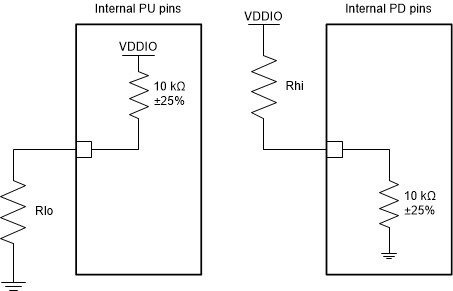ZHCSKM7G december 2019 – july 2023 DP83826E , DP83826I
PRODUCTION DATA
- 1
- 1 特性
- 2 应用
- 3 说明
- 4 Revision History
- 5 Mode Comparison Tables
- 6 Pin Configuration and Functions (ENHANCED Mode)
- 7 Pin Configuration and Functions (BASIC Mode)
- 8 Specifications
-
9 Detailed Description
- 9.1 Overview
- 9.2 Functional Block Diagram
- 9.3
Feature Description
- 9.3.1 Auto-Negotiation (Speed/Duplex Selection)
- 9.3.2 Auto-MDIX Resolution
- 9.3.3 Energy Efficient Ethernet
- 9.3.4 EEE for Legacy MACs Not Supporting 802.3az
- 9.3.5 Wake-on-LAN Packet Detection
- 9.3.6 Low Power Modes
- 9.3.7 RMII Repeater Mode
- 9.3.8 Clock Output
- 9.3.9 Media Independent Interface (MII)
- 9.3.10 Reduced Media Independent Interface (RMII)
- 9.3.11 Serial Management Interface
- 9.3.12 100BASE-TX
- 9.3.13 10BASE-Te
- 9.3.14 Loopback Modes
- 9.3.15 BIST Configurations
- 9.3.16 Cable Diagnostics
- 9.3.17 LED and GPIO Configuration
- 9.4 Programming
- 9.5 Register Maps
- 10Application and Implementation
- 11Power Supply Recommendations
- 12Layout
- 13Device and Documentation Support
- 14Mechanical, Packaging, and Orderable Information
9.4.1 Hardware Bootstraps Configuration
DP83826 uses many of the functional pins as strap options to place the device into specific modes of operation. The values of these pins are sampled at power up or hard reset. During software resets, the strap options are internally reloaded from the values sampled at power up or hard reset. The strap option pin assignments are defined below. Configuration of the device may be done through the strap pins or through the management register interface. A pullup resistor or a pulldown resistor of suggested values may be used to set the voltage ratio of the strap pin input and the supply to select one of the possible selected modes. All strap pins have two levels.
 Figure 9-10 Strap Circuit
Figure 9-10 Strap Circuit| Mode (1) | SUGGESTED RESISTORS | |
|---|---|---|
| RHI (kΩ) | RLO (kΩ) | |
| INTERNAL 10-kΩ PULLDOWN (PD) PINS | ||
| 0-DEFAULT | OPEN | OPEN |
| 1 | 2.49 | OPEN |
| INTERNAL 10-kΩ PULLUP (PU) PINS | ||
| 0 | OPEN | 1.5 |
| 1-DEFAULT | OPEN | OPEN |